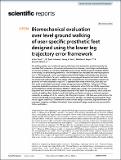Biomechanical evaluation over level ground walking of user-specific prosthetic feet designed using the lower leg trajectory error framework
Author(s)
Prost, Victor; Johnson, W Brett; Kent, Jenny A; Major, Matthew J; Winter, Amos G
DownloadPublished version (2.929Mb)
Publisher with Creative Commons License
Publisher with Creative Commons License
Creative Commons Attribution
Terms of use
Metadata
Show full item recordAbstract
<jats:title>Abstract</jats:title><jats:p>The walking pattern and comfort of a person with lower limb amputation are determined by the prosthetic foot’s diverse set of mechanical characteristics. However, most design methodologies are iterative and focus on individual parameters, preventing a holistic design of prosthetic feet for a user’s body size and walking preferences. Here we refined and evaluated the lower leg trajectory error (LLTE) framework, a novel quantitative and predictive design methodology that optimizes the mechanical function of a user’s prosthesis to encourage gait dynamics that match their body size and desired walking pattern. Five people with unilateral below-knee amputation walked over-ground at self-selected speeds using an LLTE-optimized foot made of Nylon 6/6, their daily-use foot, and a standardized commercial energy storage and return (ESR) foot. Using the LLTE feet, target able-bodied kinematics and kinetics were replicated to within 5.2% and 13.9%, respectively, 13.5% closer than with the commercial ESR foot. Additionally, energy return and center of mass propulsion work were 46% and 34% greater compared to the other two prostheses, which could lead to reduced walking effort. Similarly, peak limb loading and flexion moment on the intact leg were reduced by an average of 13.1%, lowering risk of long-term injuries. LLTE-feet were preferred over the commercial ESR foot across all users and preferred over the daily-use feet by two participants. These results suggest that the LLTE framework could be used to design customized, high performance ESR prostheses using low-cost Nylon 6/6 material. More studies with large sample size are warranted for further verification.</jats:p>
Date issued
2022Department
Massachusetts Institute of Technology. Department of Mechanical EngineeringJournal
Scientific Reports
Publisher
Springer Science and Business Media LLC
Citation
Prost, Victor, Johnson, W Brett, Kent, Jenny A, Major, Matthew J and Winter, Amos G. 2022. "Biomechanical evaluation over level ground walking of user-specific prosthetic feet designed using the lower leg trajectory error framework." Scientific Reports, 12 (1).
Version: Final published version